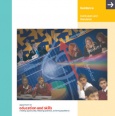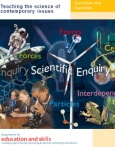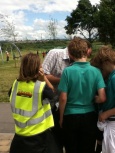Teaching approaches: Group talk
- Active learning
- Applying and consolidating
- Argumentation
- Assessment
- Classroom management
- Collaboration
- Curriculum development
- Curriculum planning
- Dialogue
- Differentiation
- Discussion
- Drama
- Exploring and noticing structure
- Games
- Group talk
- Group work
- Higher order
- Homework
- Inclusion
- Inquiry
- Introduction
- Investigation
- Language
- Learning objectives
- Mathematical thinking
- Modelling
- Narrative
- Open ended
- Planning
- Planning for interactive pedagogy
- Planning for professional development
- Posing questions and making conjectures
- Questioning
- Reasoning
- Reasoning, justifying, convincing and proof
- Scientific method
- Sharing practice
- The ORBIT Resources
- Thinking strategically
- Visualisation
- Visualising and explaining
- Whole class
- Working systematically
Why Group Talk Matters
One of the prime goals of education is to enable children to become more adept at using language, to express their thoughts and to engage with others in joint intellectual activity (their communication skills). A second important goal is to advance children's individual capacity for productive, rational and reflective thinking (their thinking skills). Dialogic talk can help achieve both these goals. The work of the Russian psychologist Vygotsky is relevant for understanding why this is so.4 He suggested that using language to communicate helps us learn ways to think. As he put it, what children gain from their 'intermental' experience (communication between minds through social interaction) shapes their 'intramental' activity (the ways they think as individuals). What is more, he suggested that some of the most important influences on the development of thinking will come from the interaction between a learner and more knowledgeable, supportive members of their community.
Although developed over half a century ago, Vygotsky's intriguing ideas have only really been put to the test in recent years. Now research has confirmed the validity of some of his claims about the link between language use and the learning of ways of thinking. Research has shown that teachers' modelling of ways of asking questions, offering explanations and providing reasons can have a significant and positive effect on how children use language in problem-solving tasks.5 Research by myself and colleagues has shown that a programme of carefully designed teacher-led and group-based activities enables children not only to become better at talking and working together but also at solving problems alone.6 The group-based activities of this programme are very important; but equally important is the kind of dialogue a teacher uses in whole-class plenaries and group monitoring. It is no coincidence that the teacher in the example above has been involved in this programme. And this brings us back to 'dialogic talk'. (Adapted from The educational value of dialogic talk in whole-class dialogue, section DialogicTalk).
The Importance of Talk
Recent research (see the collection edited by Littleton and Howe (2010)) has shown the importance of the link between spoken language, learning and cognitive development (e.g. Mercer, Wegerif & Dawes, 1999; Mercer, Dawes, Wegerif & Sams, 2004 – see below). Through using language and hearing how others use it, children become able to describe the world, make sense of life's experiences and get things done. They learn to use language as a tool for thinking, collectively and alone. However, children will not learn how to make the best use of language as a tool for communicating and thinking without guidance from their teachers. School may provide the only opportunity many children have for acquiring some extremely important speaking, listening and thinking skills. (Adapted from The Importance of Speaking and Listening, section ImportanceOfTalk).
Exploratory Talk and the Thinking Together approach
One approach to thinking about group talk has come out of the Thinking Together project based at the University of Cambridge. In this approach, ‘group talk’ is characterised as one of three ‘types’ – cumulative, disputational, or exploratory (Mercer & Littleton, 2007) as Table 1 indicates.
Table 1 - Typology of Talk
| Type of Talk | Characteristics | Analysis |
| Disputational | “Characterised by disagreement and individualised decision making. There are few attempts to pool resources, to offer constructive criticism or make suggestions.” | “short exchanges, consisting of assertions and challenges or counter-assertions (‘Yes it is.’ ‘No it’s not!’).” |
| Cumulative | “Speakers build positively but uncritically on what the others have said. Partners use talk to construct ‘common knowledge’ by accumulation.” | “Cumulative discourse is characterized by repetitions, confirmations and elaborations.” |
| Exploratory | “Partners engage critically but constructively with each other’s ideas. Statements and suggestions are offered for joint consideration. These may be challenged and counter-challenged, but challenges are justified and alternative hypotheses are offered. Partners all actively participate, and opinions are sought and considered before decisions are jointly made. Compared with the other two types, in exploratory talk knowledge is made more publicly accountable and reasoning is more visible in the talk.” | Explanatory terms and phrases more common – for example, ‘I think’ ‘because/’cause’, ‘if’, ‘for example’, ‘also’
|
Adapted from (Mercer & Littleton, 2007, pp. 58–59)
The Thinking Together site at the University of Cambridge gives some typical sequences of each talk type[1] (Mercer, 2008) in small group work.
It is important to note that often dialogue will contain elements of each of these, and indeed that there are times when one ‘type’ of talk might be more appropriate than another – however generally speaking, higher levels of exploratory talk are associated with the educational gains discussed in the introduction to this chapter. A typical pattern of research in these studies has involved an intervention including the development of classroom ‘ground rules’, followed by lessons which are specifically designed to encourage high quality, dialogic, talk which engages pupils in explaining. The typology provides teachers with a simple way to understand the nature of the talk in their own classrooms, and – through encouraging explanation, elaboration, and mutual listening – some clear ways to improve the quality of the talk, as shall now be outlined further.
Ground Rules
Ground Rules are important to consider in order to establish effective group talk in classroom contexts. Again, the resources on the Thinking Together website website[2] are useful for this purpose.
Exploratory Talk
Such ground rules should be designed to encourage mutual respect, and understanding, while also fostering high quality critique and reasoning through dialogue.
What Does Group Talk Look Like?
What is meant by ‘group talk’ and ‘argument’?
Group talk includes any activity where pupils’ ideas are explored verbally between pupils, even if the final product is written or practical. It includes verbal argument (in this context the word argument is used to describe discussion between pupils who hold differing views) as much as more formal debates (about contentious topics such as genetic engineering). Group talk can be both collaborative and competitive.
Stop and think
Before reading ahead, jot down your first thoughts to complete the following statements:
- An activity a science/maths teacher might carry out that could be called a ‘group talk’ activity is …
- If the activity was successful, what I would expect to see the pupils doing is …and what I would expect to hear in their conversations is …and what I would expect to see the teacher doing is …
- The benefits to the learner of science/maths would be …
- A teacher might not use group talk activities, giving reasons, such as …
What does successful group talk and argument look like?
When you take part in productive talk as an adult, you make suggestions and support, modify or clarify others’ views. You challenge ideas, ask questions to seek clarification, summarise and evaluate the pros and cons. You care about your own opinions, but allow others to shape and counter them.
In lessons where productive group talk is taking place you will see pupils discussing ideas with each other independently of, but guided by, the teacher. Pupils will often be turning to face each other, making and maintaining eye contact with others and using animated expressions with their eyes, face and through gesture. They will want to convince others, but will be looking for opportunities to consider others’ views. Words and phrases related to reasoning (such as because, why?, what if ...?) will be used. At times, pupils will be thinking and saying little as they listen to others. The teacher will be aware of the progress of the conversations and intervening without interrupting the flow of the talk. The pupils will be in control of the time taken on a discussion and will be clear on what they are expected to produce as a result of the activity.
When the group talk is over, pupils may have changed their minds at least once. They will be able to explain their current viewpoint and any previous opinions they held, as well as some of the views held by others.
Why do it? What are the benefits to the learner?
- Higher-level thinking Pupils are challenged to defend, review and modify their ideas with their peers. It encourages reflection and metacognition (thinking about one’s own thinking). Pupils often communicate ideas better with other pupils than with teachers.
- Assessment for learning Effectively reveals the progress of the pupil to the teacher, encouraging the pupil to self- and peer-assess while allowing the teacher to plan more effectively. As such, group talk complements methods embraced as Assessment for learning.
- Illustrating science in action Working scientists use group talk – in class it models how they work, supporting the teaching of the ‘ideas and evidence’ aspects of scientific enquiry.
- Developing the whole child The ability to resolve disagreements is a life-skill.
Pupils become more reflective as they try to arrive at a consensus by expressing different points of view; or work collaboratively to explore ideas, plan and make decisions. Further, it supports the development of literacy.
- Pupil motivation and emotional involvement When argument is taking place, and pupils are actively prompted and provoked to defend a point of view – by the teacher and by others – it raises the emotional involvement in a topic, so that pupils are more engaged. In essence, they are being encouraged to ‘care’ about the science viewpoint they have, and to take a stand for or against it, even if they concede to others along the way. These features are more common in good English, RE and humanities lessons.
- Variety and learning styles Can be used as an alternative to written or practical work (for example, experiments), or just listening as the teacher explains and demonstrates. Group talk encourages the use of different learning styles and thus can be inclusive to pupils excluded from more traditional (and often written) activities.
Why is group talk relatively uncommon in science and maths lessons? What are the issues expressed by teachers?
- External factors Many teachers may feel a pressure to ‘deliver the curriculum’. There is no time in the lesson to do more than impart information. Also, the teacher may be concerned about having evidence of work having taken place (for example, usually something written down in books) – for others in the school, for parents or for Ofsted.
- Internal factors The teacher may be reluctant to take a risk with group talk because they are afraid that discipline will be a problem. They do not feel comfortable with the apparent loss of control and, as their pupils are not used to being given this level of freedom to express their ideas, they may be reluctant or misbehave. If group talk has been tried in the past it may have been unsuccessful because of a lack of consideration of factors such as classroom layout and teacher behaviour.
When are pupils more likely to engage in group talk and argument?
- when seating arrangements and environment are planned in order to facilitate discussion;
- when the teacher’s language and non-verbal communication are planned in advance in order to promote pupil confidence in the stimulus material for group talk;
- when the teacher withholds their opinion, or the answers for longer than usual;
- when groupings are chosen by the teacher, and are regularly changed;
- when timings are specifically used and usually kept short;
- when group talk is used regularly and becomes part of everyday science lessons.
It is the teacher skills of running group talk that require the most effort to develop. Once developed, they can then be used with little preparation on the part of the teacher, allowing them to be a regular feature of lessons. Teachers may also find it useful to consider the resources in the category, and to read the Group Talk in Science - Research Summary document. (Adapted from Group Talk - Benefits for Science Teaching, section Whole).
What Do Pupils Think of Group Talk?
Pupil attitudes to group talk and argument
- Pupils moving from primary to secondary classrooms are quoted in a recent study by the DfES (Curriculum continuity, 2004): ‘You were expected to work as a group’ (primary); ‘There is less group work; teachers often expect you to work individually’ (secondary); ‘There were group work rules such as taking turns, having a chair, a scribe and a timekeeper’ (primary); ‘We only have group work rules in English’ (secondary).
- In their study of pupils’ attitudes to their science education, Osborne and Collins (2000) reported how pupils they interviewed ‘appreciated teachers who were willing to engage in ‘discussions’’ and who allowed pupils to contribute. Some pupils equate ‘writing’ in science with ‘work’, with practical or discussion work seen as more engaging and providing welcome variety.
- Matthews’ (2001) project involved pupils working in small groups of varying gender mix where they are asked to reflect on their own and others involvement in group talk. He concluded that, when combined with feedback discussions, collaborative learning in the pupils studied can lead to pupils getting on better and helping each other with their learning, and that this leads to pupils liking science more and being more likely to continue with it in the future.
The emphasis in Shakespeare (2003) is to provide stimulus for argument and then provocation to continue to defend or alter one’s views in such a way that there is an emotional involvement in the science and thus greater motivation to resolve the dispute. This was supplemented by examples of phrases seen to work well in class that sustain and enhance the responses provided by pupils. In a later project, funded by Wellcome Trust and DfES entitled Running arguments? – teacher skills for creative science classrooms, D. Shakespeare, S. Naylor and B. Keogh worked with Bedfordshire teachers from Key Stage 2 to post-16 on the skills needed to run arguments in lessons. Pupils’ opinions were sought as teachers changed their practice and behaviour in class and included reference to the positive attitudes pupils developed towards regular changing of groups and the chance to work with others, including the making of new friendships. Only a small minority reported a dislike for group discussion. (Adapted from Group Talk in Science - Research Summary, section PupilAttitudes).
References
Littleton, K., & Howe, C. (2010). Educational dialogues: understanding and promoting productive interaction. Abingdon, Oxon: Routledge.
Relevant resources
| Blogs | Digital Reporters at Camp Cardboard | |

|
Children using iPads to blog about Cardboard Sculptures This activity is a cross curricula(subject) activity, involving a collaborative(tool) approach, giving children the opportunity to work together on a blog. Children were encouraged to engage in group talk(ta) and discussion(ta) in the classroom to reflect on the activity they were to report on. The activity furthers e-skills(topic) and e-safety(topic) through the use of whole class(ta) participation. The specific art activity provided a great stimulus for the blogging. Equally, however, this approach could be applied to any event in or out of school. The use of blogging and social media gave the opportunity for children to share their ideas with a wider audience, and also gave opportunities for real-time feedback to their work. The use of hand-held technology also enabled active learning(ta) as the portability of the iPads and iPods allowed them to be used outside the classroom.
| |
| CPD | Giving Oral Feedback | |

|
Developing good practice in giving oral feedback This resource discusses giving oral feedback, particularly in the context of assessment(ta), which could include whole class(ta) discussion(ta) or group talk(ta), as well as questioning(ta) contexts.
| |
| CPD | Planning for Inclusion | |

|
Planning for inclusion in your classroom This resource discusses planning(ta) for inclusion(ta), in particular as related to active learning(ta), group talk(ta) and more generally interactive pedagogy.
| |
| CPD | Using Drama Activities in your Teaching | |

|
A lesson by any other name...Using Drama across the curriculum to enhance teaching This resource highlights some strategies to use drama(ta) activities in the teaching of other subjects. Drama(ta) can provide a useful cross curricula(i) way to prompt active learning(ta) and subsequent discussion(ta) and group talk(ta).
| |
| Contemporary issues | Teaching the Science of Contemporary Issues | |

|
Find lesson inspiration aplenty from news clips and stories. This longer (32 page) resource provides useful guidance, examples, and CPD activities for exploring contemporary issues in science, particularly to stimulate effective group talk(ta) and discussion(ta), and provoke pupil's interest in science.
| |
| Discussion | Discussion in Science Teaching | |

|
Equip yourself to run a discussion in class This resource is aimed at developing student teachers’ skills in working with discussion(ta). It can be presented to them as a hand-out to accompany an activity or read as reference material. See it online at BEEP website. Although it uses a science context, the real focus of the resource is managing and organising discussion-based activities. It provides guidance on:
| |
| Discussion | The Environment for Group Talk in Science | |

|
"Ask questions rather than provide answers: ‘What’s the strength of his or her point?’ ‘How you could check that out?’ " This resource contains a set of activities and examples to discuss and work through based around maintaining group talk(ta) in whole class(ta) and group work(ta) settings, including setting up Ground Rules, and creating appropriate environments (physical and 'class rule' based) for argumentation(ta) and discussion(ta)
| |
| Group talk | Organising Group Talk in Science | |

|
The group in which students are expected to work has a huge bearing on their willingness to speak openly. Can we better manage group talk? This resource contains activities and examples relating to group talk(ta) in science lessons in whole class(ta) and group work(ta) settings.
| |
| ICT | Creating Instructional Videos | |

|
Children create instructional videos to upload to YouTube This activity is a cross-curricular(subject) activity with a literacy focus, involving a collaborative(tool) approach, giving children to opportunity to work together to produce a set of instructional resources. Children were encouraged to engage in group talk(ta) and discussion(ta) in the classroom to reflect on what they should include in their videos. The activity furthers e-skills(topic) through the use of whole class(ta) participation. It develops e-safety(topic) skills through discussion of the issues relating to posting digital content online. Children were allowed to choose their own subject for the video, although this could be set by a teacher with a specific outcome in mind, or could be tailored to cover a particular topic or subject. It could, for instance, be used to explain their mathematical thinking(ta).
| |
| QR codes | Editing Using QR Codes to Engage Children with Learning | |

|
Children using digital literacy to engage with reading and writing This lesson idea uses technology to promote active learning(ta) as resources were produced to be located and explored in a public park. The early stage of the activity, involving the creation of the resources by the children, required discussion(ta) involving the whole class(ta). Group talk(ta) was also employed as a strategy, with the children agreeing on a narrative(ta) outline relating to the event. The creation of the online materials encouraged development of e-skills(topic).
The later stages of activity, where the children were looking for clues, required them to ask questions(ta) and to take a collaborative(tool) approach to find a solution, based on the digital texts they found. | |
| Shape | Getting Your Formulae in Shape | |

|
Solving a card sort for perimeter, volume and area formulae This resource provides an opportunity for some revision of shape formulae - perimeter, area, and volume. It encourages pupils to engage in effectivereasoning(ta), and group talk(ta), and could be used as an effective assessment(ta) tool. The task could be differentiated(ta), or extended for a whole class by cutting the 'formulae' lines off the bottom of each hexagon, and asking students to match these to the shapes, prior to matching the shapes to the formulae type.
| |
| Standard Index Form | An Introduction to the Standard Index Form | |
Working out the rules according to which a calculator displays large numbers The Standard Index Form is a key idea for mathematicians and scientists. The notion that we choose to write numbers in this way requires some explanation. So in this activity, pupils take part in an investigation(ta) on how standard index form works. This is a higher order(ta) problem solving context where students are encouraged to engage in mathematical thinking(ta). They may be involved in whole class(ta) or small group work(ta) discussion(ta), so they have a good opportunity to practice using mathematical language(ta) and questioning(ta).
This means that students do not need to be able to explain their ideas in full: they can use the calculator's feedback to discover whether their ideas are correct or not. This is also an exciting way for pupils to realise an initial idea that fits the data may need to be extended when new data arises. This resource therefore aims to develop investigative skills, as well as introduce pupils to standard index form in a memorable way. The pupils can later use their knowledge of indices in discussion(ta) and group talk(ta) as they explain what is happening. | ||
| Statistics | Cubic Equations and Their Roots | |

|
To interactiviley explore and understand complex mathematics with GeoGebra This lesson features a ‘real life’ example for students to explore using visualisation(ta) via GeoGebra. The focus on ‘real life’ increases student motivation.
The activity engages pupils in group talk(ta), mathematical thinking(ta) and vocabulary(ta). This open ended(ta) task encourages higher order(ta) thinking, and encourages whole class(ta) discussion(ta)/questioning(ta) and inquiry(ta) projects. | |
